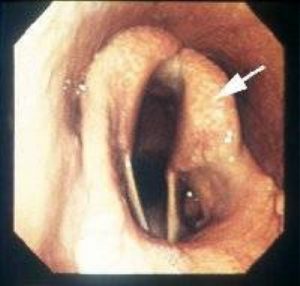LA Respiratory Issues
Laryngeal disorders
The larynx includes the epiglottis, paired arytenoids and other laryngeal structures. The larynx connects the pharynx to the trachea.

Dysfunction of the larynx leads to swallowing disorders and impaired performance due to decreased airway diameter. Exercise endoscopy is required to accurately evaluate these disorders in horses. These disorders, while sometimes present, are generally not an issue in other species. Calves and young feedlot cattle do get necrotic laryngitis; temporary tracheotomy may assist in treatment.
Laryngeal disorders
Epiglottic entrapment

The epiglottis moves up during swallowing to protect the airway. The extra tissue below the epiglottis that permits this movement can also “entrap” the epiglottis in a pillowcase type sheath. This can happen due to congenital abnormalities in the epiglottis and/or membrane and with throat inflammation. The entrapping tissue catches air on exhalation. The trapped air billows the tissue, creating turbulence and noise. The entrapment also prevents normal movement of the epiglottis. Horses often present with exercise intolerance and cough. Diagnosis is made on endoscopy and/or radiographs. With the preferred treatment, a laser is used to split the membrane, releasing the epiglottis from the membrane.
Note that you can’t see the scalloped edges or vessels of the epiglottis in the image. It looks like it has a pillowcase over it. Compare this to DDSP in which there is no epiglottic outline visible.
Laryngeal hemiplegia

Both arytenoids should abduct during exercise to open the airway for maximal airflow. In the image to the right, the left arytenoid isn’t moving properly. With laryngeal hemiplegia, generally the left arytenoid doesn’t work at all or doesn’t work well. The laryngeal branch of the vagus nerve is the longest nerve in the body and appears to degenerate fairly often. This degeneration leads to neurogenic atrophy of the CAD (cricoarytenoideus dorsalis) muscle. The CAD muscle is responsible for abduction of the arytenoid during exertion. When the arytenoid doesn’t abduct properly, it vibrates during exercise and impairs airflow, leading to poor performance. Diagnosis is via exercise endoscopy. Surgery involves replacing the CAD muscle with a suture to abduct the muscle, removing the arytenoid or transposing a nerve to reinnervate the muscle. Performance will usually improve after surgery but horses are more prone to upper airway inflammation, swallowing disorders and recurrent airway compromise. The condition usually develops in young horses and seems to be familial.
Clinical signs of unilateral disease: exercise intolerance and noise with exercise
 Arytenoid chondritis
Arytenoid chondritis
Inflammation of the arytenoid leads to malformation and dysfunction of the arytenoid. Medical treatment is sometimes effective but often the arytenoid must be removed to open the airway. When the arytenoid is removed, horses are at risk of food aspiration and persistent coughing. In the image on the left, note the enlarged right arytenoid with a protuberance extending across the airway. Look for arytenoid chondritis if you see signs of right side arytenoid dysfunction.
In calves, arytenoid chondritis can develop with oral necrobacillosis due to Fusobacterium necrophorum.
Clinical signs of unilateral disease: exercise intolerance and noise with exercise
Aryepiglottic fold collapse 
The negative pressures in the upper airway of the horse can lead to collapse of soft tissue structures. The tissue between the epiglottis and larynx can be pulled into the airway. Horses present with exercise intolerance and noise. Laser surgery may help.
Clinical signs: exercise intolerance and noise with exercise
Subepiglottic cysts

Cysts can develop in the larynx and interfere with function of the epiglottis. Problems with the epiglottis lead to swallowing disorders and feed aspiration. Cysts can be treated by laser or formalin injections.
Clinical signs : dysphagia, cough
Resources
Respiratory distress in the adult and foal, VCNA (2021) 37:311-325
Update on laryngeal disorders and treatment, VCNA: Equine Practice, April 2015, Vol.31(1), pp.13-26
Upper airway conditions affecting the equine athlete, VCNA: Equine Practice, August 2018, Vol.34(2), pp.427-441
Performance limiting laryngeal disorders– Vetfolio subscription required
Respiratory Surgery, Vet Clin Food Anim 32 (2016) 593-615

